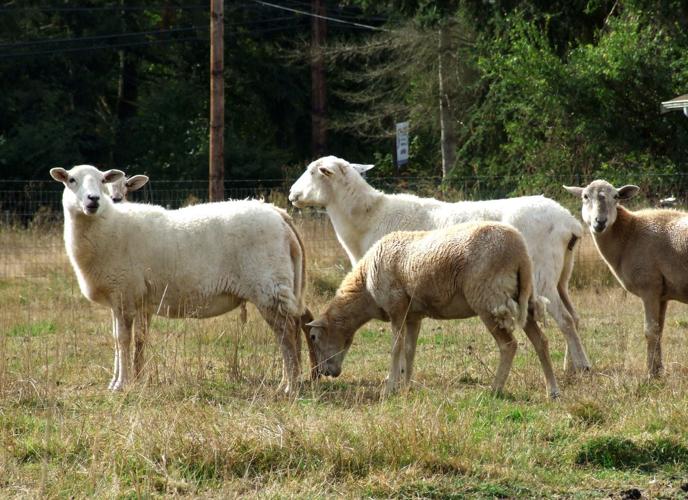Not far from the minute town of Cochise (pop. 520), Brian LaPrairie’s Katahdin sheep rest comfortably in their pastures under the early morning sun. It’s still cool, but the sheep – raised for meat rather than wool – are a hair breed, and they’ll stay comfortable even as the temperature rises. They can shelter in a shaded part of the pen if they wish, but most are lazing about in the sunshine.
LaPrairie, a retired general contractor who moved to Arizona from California nearly 20 years ago, clearly appreciates the Katahdin breed. “They’re beautiful animals, very docile, and they breed out-of-season, year-round,” he says. “Their meat is very lean.”
He knew what he wanted in a ranch when he started looking to leave California, he says. “I was looking everywhere – I liked Texas, but that humidity!” For LaPrairie, who grew up in Michigan’s sweltering, sticky summers, that scratched Texas off the list.
After a five-year search, he found the ranch that he named B Bar Z. He was delighted. Its location was good and it has a commercial well on the property – making it easy to water his livestock and orchard as well as keep the little pond behind his house topped up.
Once he settled in and had a roof over his head, LaPrairie got to work stocking the farm. Although he was at first interested in another meat sheep breed, the South African Dorper, a ram that he saw at a Texas livestock auction changed his mind. “It was the most beautiful animal I’d ever seen,” he says.
The Katahdin breed was developed at Piel Farm in Maine and gets its name from Mount Katahdin, Maine’s highest peak, says the Livestock Conservancy, which monitors heritage livestock breeds. The goal was to create a hardy sheep that didn’t need shearing. They’re medium-sized as sheep go; ewes weigh 120 to 160 pounds, rams from 180 to 250 pounds. Their color varies, and though most are polled, or hornless, sometimes horned animals occur.
At LaPrairie’s ranch, Great Pyrenees livestock guardian dogs protect the flock, which has about 100 head. The passel of puppies hasn’t quite mastered their parents’ dignity, LaPrairie notes, but the dogs keep the sheep safe from coyotes and other would-be predators.
Every month, LaPrairie loads up his stock trailer with five or six lambs, ranging in age from 6 to 8 months. He hauls them to the University of Arizona’s Food Products and Safety Laboratory, where the lambs are processed at a USDA-inspected facility. The animals are butchered, and all cuts are vacuum-sealed and frozen.
LaPrairie sells the lamb at the Sunday morning Heirloom Farmers Market at Rillito Park, where some of his loyal customers have shopped with him for 15 years, including his previous years at St. Philip’s farmers market. He also sells pork, including bacon, and chicken from the booth, although he doesn’t raise those products. And sometimes he sells fruit from his own orchard. From August and into September, that fruit is peaches, including the large, flavorful O’Henry peach that’s equally good for eating out of hand, cooking, canning and dehydrating. In the spring, he brings apricots to market. His customers start asking for them weeks before they’re ripe, he says.
I love lamb and picked up a couple of LaPrairie’s shanks to make the delectable Armenian dish called fassoulia. My Armenian-American friends taught me how to make the satisfying green bean stew decades ago when I lived in Detroit, and I have prepared it a couple of times a month ever since.
Fassoulia
Makes 4 servings
This green bean stew is a perfect candidate for your Instant Pot or other electric pressure cooker. Put everything into the pot, even if the shanks are frozen, and press the “meat/stew” button. In about 35 minutes, dinner will be ready and your kitchen’s still cool. It’ll take longer on the stove, but it’s a hands-off dish, so your only work is getting everything into the pot. You’ll want to have plenty of good bread on hand for dunking in the juices, or serve the stew over rice.
- Quick
- Easy
- Inexpensive
Ingredients
2 to 4 lamb shanks, depending on their weight (about 4 pounds, total)
2 pounds fresh green beans, topped and tailed, or about 8 cups frozen green beans
1/2 cup olive oil
1 large onion, chopped
3 cloves garlic, smashed and minced
1 teaspoon salt
ƒ teaspoon freshly ground black pepper
1 14ƒ-ounce can diced tomatoes with their juices
Water, tomato juice or chicken broth, if needed
Sturdy bread or cooked rice, for serving
Preparation
Combine all ingredients in the cooking pot of an electric pressure cooker, or in a heavy pot with a lid if you’d like to cook this on the stove.
To cook in an Instant Pot or similar electric pressure cooker, press the “meat/stew” button, about 35 minutes at high pressure. When cooking time is up, allow pressure to reduce naturally, about 15 to 20 minutes. To cook on the stove, bring the mixture to a boil, cover the pot and reduce heat to simmer. Cook for 45 minutes, checking occasionally and adding water, tomato juice or broth as needed so the mixture doesn’t dry out. When the lamb shanks are tender to the fork, proceed to the next step.
Either way, remove the lamb shanks and set them aside until cool enough to handle. Strip the meat from the bones, chop it coarsely and return the meat to the pot. Discard the bones.
Taste and correct seasoning, adding more salt and pepper if need.
Serve with sturdy bread or over rice.
Next week: April and Earl King of FourKings Kitchen create high-quality granola suitable for a variety of eating plans, including keto, paleo and more.





